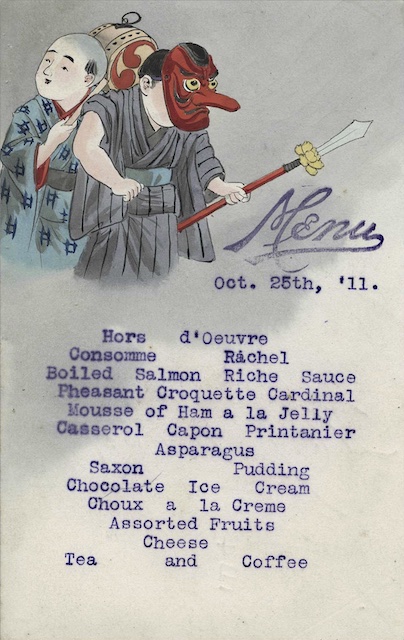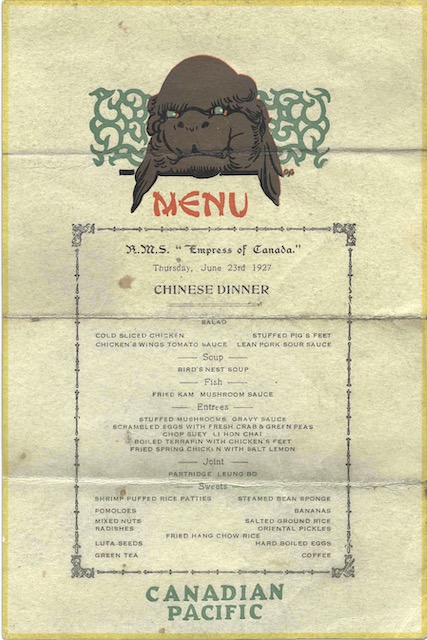Here are two menus that I include together only because they both feature Japanese masks. Although both are cards instead of folders, they have few other similarities, as they were used sixteen years apart on two very different ships.
 Click image to view and download a PDF of this menu from the University of British Columbia Chung collection.
Click image to view and download a PDF of this menu from the University of British Columbia Chung collection.
The first is dated 1911 and, though the name of the ship isn’t given, it would have to have been one of CP’s first empresses: Asia, India, or Japan. The menu also doesn’t say whether it was for lunch or dinner, but given how few items are on it, I’d have to guess lunch.
In fact, it is hard to say that it offered any main courses. Pheasant croquettes, mousse of ham, and capon-vegetable casserole all sound like side dishes to me. Asparagus is the only vegetable and there are no potatoes. There are, however, a choice of three desserts plus fruits and cheese.
 Click image to view and download a PDF of this menu from the University of British Columbia Chung collection.
Click image to view and download a PDF of this menu from the University of British Columbia Chung collection.
The second menu was used on the Empress of Canada in 1927. This ship was built for Canadian Pacific after the Great War and made its maiden voyage in May, 1922. When it was christened, Canadian Pacific’s president complained that it cost more than three times as much to build as ships before the war, forcing CP to nearly triple first-class fares. If he was referring to the empresses of Asia/Russia, he didn’t mention that they were smaller ships with only 75 percent the capacity of the Canada, but he was still correct that costs in the 1920s were rising after several decades of deflation.
Like the 1911 menu, this is a card, not a folder, and it present a “Chinese dinner,” which was probably more authentic than people today get at most North American Chinese restaurants. It included such delights as stuffed pig’s feet, boiled terrapin with chicken’s feet, shrimp puffed rice patties, and steamed bean sponge. The soup was bird’s nest soup and the fish course was fried kam (which is a way of cooking fish, not a kind of fish).
On an Atlantic empress, the course called “joint,” which was the main course, would have been beef, pork, or lamb, but here it was partridge Leung Bo. Leung Bo — or, more properly, Bo Leung — is a common personal name in China, so my guess is that it was the name of the chef, not a specific cooking style.
